History of Fort Sullivan
Last Line of Defense: 1775 - 1874
with
Brief Descriptions of Camp Long (1898), Camp Heywood (1898),
Portsmouth Naval Prison (1905-1974), and the U.S. Marine Barracks (1808-1987).
(note: this is not a history of the Portsmouth Naval Shipyard)
The site of Fort Sullivan is on Seavey's Island, part of the Portsmouth Naval Shipyard, near the old water reservoir site. The old Naval Prison now occupies the top of the bluff near where the fort is believed to have been built.
The earthwork fort was first built in 1775 by the New Hampshire militia, in conjunction with Fort Washington on Peirce's Island and Clark's Point (Shaw's Hill) Redoubt on New Castle Island, and named after Major General John Sullivan, commander of New Hampshire forces in the American Revolution, and overall commander of the Portsmouth defenses in 1775. (see also N.H. war heroes) Captain Ezekiel Worthen drew the plans for Fort Sullivan, as well as Fort Washington and Clark's Point, and was later, with the rank of Major, to relieve General Sullivan as overall commander of the Portsmouth defenses. The fort was first under the command of a Colonel Wingate in 1775, and then Captain Eliphalet Daniels after 1776, with one lieutenant and 25 artillerists. It was probably not garrisoned after 1778. The fort was regarrisoned and rearmed in 1814 as British warships patrolled off the coast. In 1861 two 8-inch smooth-bore Rodmans were emplaced at the old earthwork. There was another battery built at the Shipyard, on Dennett's Island, facing downtown Portsmouth, which consisted of several 18-pounder guns. The fort was completely rebuilt in April 1863 by the US Navy and Marines based at the Shipyard, as a naval battery of eleven 8-inch smooth-bore Rodmans along with barracks, which would protect the Shipyard from possible Confederate naval attacks that might slip past Forts Constitution and McClary. In July 1863 the fort was manned by 117 Negro "contrabands" brought up from the South, who were to be trained as sailors and soldiers under command of several white officers to relieve the manpower shortage at the time. They served for 10 months until May 1864, when they were transferred to serve as part of the crew for a "new" ship being outfitted at the yard, the USS New Hampshire (formerly the USS Alabama). In August 1863 a controversy arose concerning the Negros manning the fort. A target practice shot went astray and hit a boat in the harbor near Pest Island, killing a twelve-year-old boy from New Castle, and wounding four other passengers.
Seavey's Island was not part of the actual Shipyard holdings until 1866, after which the fort was soon dismantled. The fort site was virtually demolished in 1901 when the new reservoir and water tanks were built. Nearby Henderson's Point was demolished in 1905 in order to enlarge the ship channel for the upcoming submarine shipbuilding program. (See also: "They blew up Henderson's Point!").
The area is off-limits to the general public, as this is on an active military base. The base is, however, open to the public on the last Saturday of each month, primarily for the Shipyard Museum and Research Library. The site of the fort near Henderson's Point is marked on a walking tour of the Shipyard. Due to post 9-11 security restrictions, the Shipyard is now permanently closed to the general public without prior approval.
GPS Fort Sullivan Benchmark (OC2273) - N 43° 04.540 W 070° 43.984 (NAD 83)

The site of Fort Sullivan, with the Naval Prison in left background.

The historical marker for Fort Sullivan, erected in 2000.

photo courtesy of PNSY Museum
The site of the fort as seen in 1901, with the newly built water stand-pipe, and the water reservoir used for the steam engines at the Yard. The stand-pipe still stood until the 1940s. The Wentworth Hotel in New Castle is in the far left background.
GPS Stand-pipe (OC2274) - N 43° 04.563 W 070° 43.981 (NAD 83)
The old Naval Prison, commonly referred to as "The Castle", was built beginning in 1905, and received its first military prisoners in 1908. It replaced a temporary stockade called Camp Long that was originally used for 1,612 Spanish naval POWs in July-September 1898. The camp was named after Secretary of the Navy John Long. A Marine detachment from the Boston Naval Shipyard provided guard detail for the camp in 1898. The central turreted structure of the prison was added in 1912.
GPS Prison Cupola (OC2277) - N 43° 04.576 W 070° 43.864 (NAD 83)

courtesy of PNSY Museum
An illustration of Camp Long
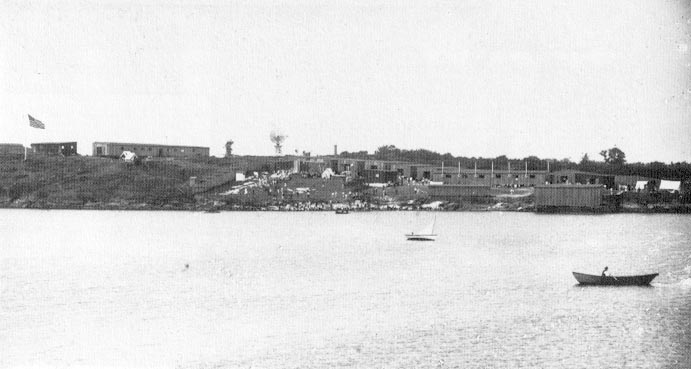
photo courtesy of PNSY Museum
Camp Long on Seavey's Island, 1898
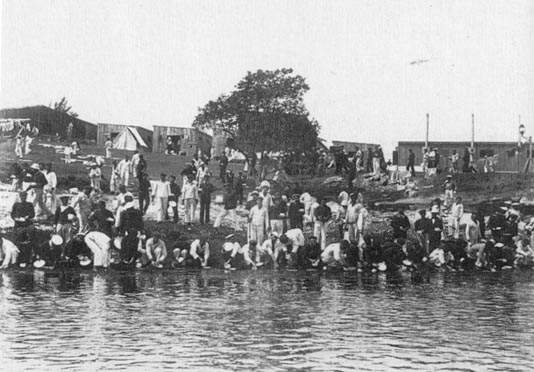
photo courtesy of PNSY Museum
Spanish prisoners washing their clothes in the river, according to the original caption.
Some prisoners seem to have other thing besides clothes in their hands.

courtesy of National Archives
The liner "City of Rome" which brought the Spanish POWs back to Spain.
Shown off of Kittery Point, Maine, on September 12, 1898.
See additional photos of the troop ships bringing the Spanish POW's to Portsmouth.
Prison population in 1918 was at 2,295 inmates. An additional wing was added in 1942, matching the architecture of the original section, and the large 8-story south wing, also known as the "Fortress", was built in 1943 to accommodate the swelled ranks of wartime convicts. It was also used in 1945 to house the crews of several captured German U-boats. The prison population reached its peak of 3,088 in 1945. It was finally closed in 1974, with the remaining inmates transferred to Fort Leavenworth, Kansas. This was the primary prison facility for the entire U.S. Navy and Marine Corps during its heyday, equal in security and reputation to the military prisons at Fort Leavenworth, and Alcatraz Island, California. The building, closed to the public, now sits abandoned and derelict, awaiting some future re-purposing.

The Castle
A temporary Marine encampment called Camp Heywood, named after the USMC Commandant of the time, Col. Charles Heywood, was established on the Shipyard in August-September 1898 following the Spanish-American War, for the returning veterans of the First Marine Battalion. The troops needed a cooler climate to recuperate after the campaign in tropical Cuba. The site, just north of the Naval Prison, was later used as a Naval Reservists' camp during World War I.
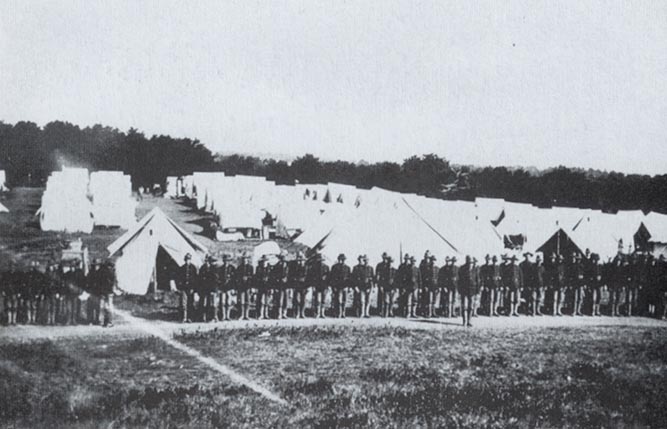
photo courtesy of PNSY Museum
Camp Heywood, 1898

photo courtesy of PNSY Museum
The Magazine House (Building 31), built in the 1840s, as seen probably circa 1870s. This still exists, as well as two others nearby. When warships entered the yard, powder and shells were off-loaded to the magazines to prevent any unfortunate accidents at the docks.
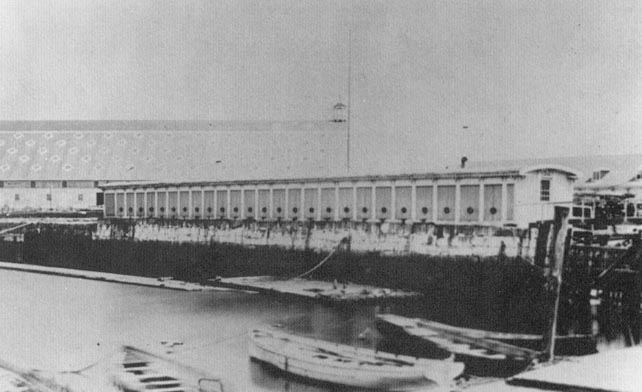
photo courtesy of PNSY Museum
The saluting battery, built in 1876, as seen in the 1890s. The Franklin Shiphouse is in the background, and both were destroyed by fire in 1936.

The USMC Barracks, 1824-1987.
The Marines were first stationed here in 1808.
The post was permanently withdrawn in 1987.
Now currently used by the PNSY Police Department.

photo by The Davis Brothers, from a copy courtesy of PNSY Museum
The US Marine Barracks as seen in 1870.

photo courtesy of PNSY Museum
What happened to all of those cannonballs seen in old photographs?
Cannonballs from the Shipyard and surrounding forts being sent out for scrap-iron salvage in 1942.

Two Fisher MK22 (1942) 3-inch submarine deck guns placed near the Marine Barracks as a memorial.
List of Sources Used
See also Portsmouth Naval Shipyard History official Navy website
History of Portsmouth Naval Shipyard from SeacoastNH.com
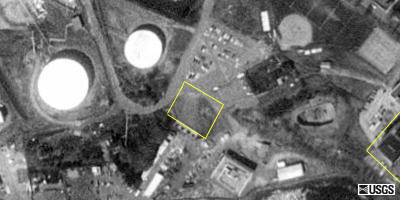

courtesy of Microsoft Terraserver
A 1992 USGS Satellite Image of Sullivan's Point
Naval Prison location outlined at center, Fort Sullivan site outlined at left, unknown pentagon-shaped structure foundation location outlined at far right.
NOTE: Strawbery Banke Museum images displayed on this page are to be used for non-commercial, personal, and private use only. Any other use, including publication, copying, or redistribution of said images in any manner is prohibited without prior written permission from Strawbery Banke Museum, Portsmouth, New Hampshire, and from American Forts Network.


















